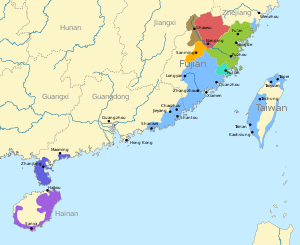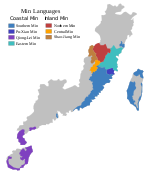|
Southern Min
Southern Min (simplified Chinese: 闽南语; traditional Chinese: 閩南語; pinyin: Mǐnnányǔ; Pe̍h-ōe-jī: Bân-lâm-gí/gú; lit. 'Southern Min language'), Minnan (Mandarin pronunciation: [mìn.nǎn]) or Banlam (Min Nan Chinese pronunciation: [bàn.lǎm]), is a group of linguistically similar and historically related Chinese languages that form a branch of Min Chinese spoken in Fujian (especially the Minnan region), most of Taiwan (many citizens are descendants of settlers from Fujian), Eastern Guangdong, Hainan, and Southern Zhejiang.[5] Southern Min dialects are also spoken by descendants of emigrants from these areas in diaspora, most notably in Southeast Asia, such as Singapore, Malaysia, the Philippines, Indonesia, Brunei, Southern Thailand, Myanmar, Cambodia, Southern and Central Vietnam, as well as major cities in the United States, including San Francisco, Los Angeles and New York City. Minnan is the most widely-spoken branch of Min, with approximately 50.6 million speakers as of 2021.[6] The most widely spoken Southern Min language is Hokkien, which includes Taiwanese. Other varieties of Southern Min have significant differences from Hokkien, some having limited mutual intelligibility with it, others almost none. Teochew, Longyan, and Zhenan are said to have general mutual intelligibility with Hokkien, sharing similar phonology and vocabulary to a large extent.[7] On the other hand, variants such as Datian, Zhongshan, and Qiong-Lei have historical linguistic roots with Hokkien, but are significantly divergent from it in terms of phonology and vocabulary, and thus have almost no mutual intelligibility with Hokkien. Linguists tend to classify them as separate languages. Geographic distributionMainland ChinaSouthern Min dialects are spoken in southern Fujian, specifically in the cities of Xiamen, Quanzhou, Zhangzhou, and much of Longyan, hence the name. In addition, varieties of Southern Min are spoken in several southeastern counties of Wenzhou in Zhejiang, the Zhoushan archipelago off Ningbo in Zhejiang, the town of Sanxiang at the southern periphery of Zhongshan in Guangdong,[8] and in the Chaoshan (Teo-swa) region in Guangdong. The variant spoken in Leizhou, Guangdong as well as in Hainan is classified as Hainanese and is not mutually intelligible with mainstream Southern Min or Teochew.[citation needed] Hainanese is classified in some schemes as part of Southern Min and in other schemes as separate.[example needed][citation needed] Puxian Min was originally based on the Quanzhou dialect, but over time became heavily influenced by Eastern Min, eventually losing intelligibility with Southern Min.[9] TaiwanThe Southern Min dialects spoken in Taiwan, collectively known as Taiwanese, is a first language for most of the Hoklo people, the main ethnicity of Taiwan. The correspondence between language and ethnicity is not absolute, as some Hoklo have very limited proficiency in Southern Min while some non-Hoklo speak Southern Min fluently.[10] Southeast AsiaThere are many Southern Min speakers among overseas Chinese in Southeast Asia. Many ethnic Chinese immigrants to the region were Hoklo from southern Fujian and brought the language to what is now present-day Malaysia and Singapore (formerly British Malaya, the Straits Settlements, and British Borneo), Indonesia (the former Dutch East Indies), the Philippines (former Spanish East Indies and later, US Philippine Islands (P.I.)), Brunei (former part of British Borneo), Southern Thailand, Myanmar (British Burma), Cambodia (former French Cambodia of French Indochina), Southern Vietnam (former French Cochinchina of French Indochina) and Central Vietnam (former French Annam of French Indochina). In general, Southern Min from southern Fujian is known as Hokkien, Hokkienese, Fukien, or Fookien in Southeast Asia and is mostly mutually intelligible with Hokkien spoken elsewhere. Many Southeast Asian ethnic Chinese also originated in the Chaoshan region of Guangdong and speak Teochew language, the variant of Southern Min from that region, particularly Thailand, Cambodia, Southern Vietnam, Malaysia, Singapore, Indonesia, etc. In the Philippines, Philippine Hokkien is reportedly the native or heritage language of up to 98.7% of the Chinese Filipino community in the Philippines, among whom it is known in Hokkien Chinese: 咱人話 / 咱儂話; Pe̍h-ōe-jī: Lán-nâng-ōe / Lán-lâng-ōe / Nán-nâng-ōe; lit. 'our people's language'. Southern Min speakers form the majority of Chinese in Singapore, with Hokkien being the largest group and the second largest being Teochew. Despite the similarities, the two groups are rarely viewed together as "Southern Min". ClassificationThe variants of Southern Min spoken in Zhejiang province are most akin to that spoken in Quanzhou. The variants spoken in Taiwan are similar to the three Fujian variants and are collectively known as Taiwanese. Those Southern Min variants that are collectively known as "Hokkien" in Southeast Asia also originate from these variants. The variants of Southern Min in the Chaoshan region of eastern Guangdong province are collectively known as Teo-Swa or Chaoshan. Chaoshan Min is of great importance in the Southeast Asian Chinese diaspora, particularly in Malaysia, Thailand, Cambodia, Vietnam, Sumatra, and West Kalimantan. The Philippines variant is mostly from the Quanzhou area as most of their forefathers are from the aforementioned area. The Southern Min language variant spoken around Shanwei and Haifeng differs markedly from Teochew and may represent a later migration from Zhangzhou. Linguistically, it lies between Teochew and Amoy. In southwestern Fujian, the local variants in Longyan and Zhangping form a separate division of Southern Min on their own. Among ethnic Chinese inhabitants of Penang, Malaysia and Medan, Indonesia, a distinct form based on the Zhangzhou dialect has developed. In Penang, it is called Penang Hokkien while across the Malacca Strait in Medan, an almost identical variant[citation needed] is known as Medan Hokkien. VarietiesThere are two or three divisions of Southern Min, depending on the criteria for Leizhou and Hainanese inclusion: More recently, Kwok (2018: 157)[11] has proposed an alternative classification, with a divergent Northern branch that includes Quanzhou dialect but not Zhangzhou dialect, as shown below: HokkienHokkien is the most widely spoken form of Southern Min, including Amoy dialect and Taiwanese. Both of these developed as a combination of Quanzhou and Zhangzhou speech. Varieties in South-East Asia include Singaporean Hokkien, Penang Hokkien, Southern Peninsular Malaysian Hokkien, Medan Hokkien, and Philippine Hokkien. Chaoshan (Teo-Swa)Teo-Swa or Chaoshan speech (潮汕片) is a closely related variant of Southern Min that includes the Kekyeo dialect, Teochew and Swatow dialects, and some consider Haklau Min to also be part of. It has limited mutual intelligibility with Hokkien, though they share some cognates with each other. Chaoshan Min is significantly different from Hokkien in both pronunciation and vocabulary, and mutual intelligibility is difficult.[12] PhonologySouthern Min has one of the most diverse phonologies of Chinese varieties, with more consonants than Mandarin or Cantonese. Vowels, on the other hand, are more-or-less similar to those of Mandarin. In general, Southern Min dialects have five to six tones, and tone sandhi is extensive. There are minor variations within Hokkien, and the Teochew system differs somewhat more. Southern Min's nasal finals consist of /m/, /n/, /ŋ/, and /~/. Sino-Xenic comparisonsSouthern Min can trace its origins through the Tang dynasty, and it also has roots from earlier periods. Hokkien people call themselves "Tang people", (Tn̂g-lâng 唐人/唐儂) which is synonymous to "Chinese people". Because of the widespread influence of the Tang culture during the Great Tang dynasty, there are today still many Southern Min pronunciations of words shared by the Sino-xenic pronunciations of Vietnamese, Korean and Japanese languages.
Writing systemsBoth Hokkien and Chaoshan (Teochew and Shantou dialects) have romanized writing systems and also respective Chinese characters. In mainland China, it is known as 閩南文 (Bân-lâm-bûn), while in Taiwan, it is known as 台文 (Tâi-bûn). The Han Chinese characters are known in mainland China and Taiwan as 漢字 (Hàn-jī / Hàn-lī). In Malaysia and Singapore, the Chinese characters are sometimes known as 唐儂字 / 唐人字 (Tn̂g-lâng-jī / Tn̂g-lâng-lī). In the Philippines, the Chinese characters are known as 咱儂字 / 咱人字 (Lán-nâng-dī) or 漢文字 (Hàm-bûn-dī). HistoryThe Min homeland of Fujian was opened to Han Chinese settlement by the defeat of the Minyue state by the armies of Emperor Wu of Han in 110 BC.[14] The area features rugged mountainous terrain, with short rivers that flow into the South China Sea. Most subsequent migration from north to south China passed through the valleys of the Xiang and Gan rivers to the west, so that Min varieties have experienced less northern influence than other southern groups.[15] As a result, whereas most varieties of Chinese can be treated as derived from Middle Chinese, the language described by rhyme dictionaries such as the Qieyun (601 AD), Min varieties contain traces of older distinctions.[16] Linguists estimate that the oldest layers of Min dialects diverged from the rest of Chinese around the time of the Han dynasty.[17][18] However, significant waves of migration from the North China Plain occurred.[19] These include:
Jerry Norman identifies four main layers in the vocabulary of modern Min varieties:
See also
References
Sources
Further reading
External links Minnan edition of Wikipedia, the free encyclopedia Wikibooks has a book on the topic of: Minnan Look up Minnan, Appendix:Amoy Minnan Swadesh list, or Appendix:Sino-Tibetan Swadesh lists in Wiktionary, the free dictionary. Wikivoyage has a phrasebook for Minnan.
|
||||||||||||||||||||||||||||||||||||||||||||||||||||||||||||||||||||||||||||||||||||||||||||||||||||||||||||||||||||||||||||||||||||||||||||||||||||||||||||||||||||||||||||||




